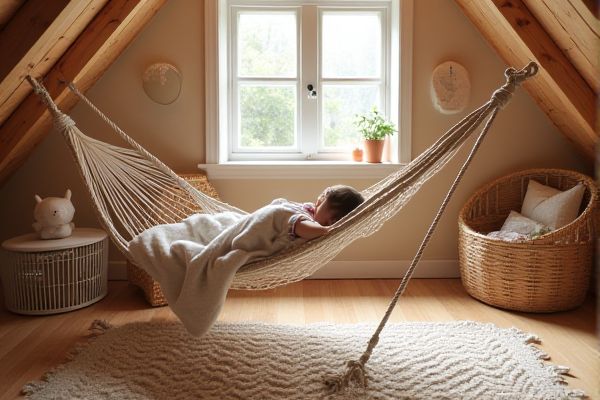
An attic toy hammock offers a lightweight, breathable solution for organizing toys, maximizing vertical space without sacrificing floor area, while storage bins provide a more structured, stackable option ideal for corralling items and keeping them dust-free. Discover which method best suits your space and organizational needs by reading the full article.
Table of Comparison
| Feature | Attic Toy Hammock | Storage Bin |
|---|---|---|
| Purpose | Space-saving toy storage in attic or play area | Organized storage for various items including toys |
| Material | Durable mesh or netting fabric | Plastic, fabric, or cardboard |
| Installation | Requires ceiling or wall mounting hooks | No installation; portable |
| Capacity | Holds lightweight, soft toys | Varies, generally holds heavier and bulkier items |
| Accessibility | Easy to spot but may require reaching up | Easy access at ground level |
| Ventilation | Excellent airflow through mesh | Depends on bin type; often less ventilated |
| Space Efficiency | Utilizes vertical space effectively | Occupies floor or shelf space |
| Price | Generally affordable, low cost | Wide price range depending on material and size |
| Maintenance | Easy to clean, washable fabric | Varies; some bins are washable or wipeable |
Attic Toy Hammock vs Storage Bin: An Overview
Attic toy hammocks maximize vertical space by securely suspending toys, preventing clutter and enhancing airflow, while storage bins offer compact, stackable solutions ideal for organizing varied items. Your choice depends on attic dimensions and accessibility, with hammocks suited for lightweight, soft toys and bins preferred for heavier or irregular items. Both options improve attic organization but vary in installation, durability, and the level of protection they provide for stored toys.
Space Efficiency: Maximizing Storage in Small Attics
An attic toy hammock maximizes storage in small attics by utilizing vertical space, freeing up valuable floor area and reducing clutter. Unlike bulky storage bins, the hammock conforms to irregular attic shapes and can hold soft toys securely while allowing easy access. Your attic's limited dimensions are optimized efficiently with a toy hammock, enhancing overall space utilization compared to rigid storage bins.
Accessibility: Easy Reach or Hidden Away?
An attic toy hammock offers easy reach by suspending toys in an open, visible space, allowing quick access and encouraging tidiness. In contrast, a storage bin hides toys away, reducing clutter but requiring opening and searching, which may limit immediate accessibility. Choosing between them depends on whether prioritizing convenience or a cleaner, concealed environment is more important for toy organization.
Organization: Keeping Toys Tidy and Sorted
An attic toy hammock maximizes vertical space by securely suspending soft toys, reducing floor clutter and enabling easy visibility and access to items. In contrast, storage bins offer compartmentalized organization ideal for sorting toys by category, enhancing tidiness but often occupying significant floor or shelf space. Choosing between the two depends on available attic layout and preferred method of maintaining sorted, accessible toy storage.
Installation and Setup: Simplicity Matters
Attic toy hammocks require minimal installation, typically involving hooks and elastic netting that can be set up within minutes, optimizing attic space without heavy tools. Storage bins demand more initial effort, often needing assembly and careful placement to maximize storage efficiency. Choosing a toy hammock enhances ease and speed of setup, making it a practical solution for quick organization in attics.
Safety Considerations: Which Is More Child-Friendly?
An attic toy hammock offers a child-friendly option by securely suspending toys off the floor, reducing tripping hazards and keeping the play area tidy. Storage bins provide stable, enclosed compartments that prevent toys from spilling but may require frequent supervision to ensure lids are safely handled, avoiding pinched fingers. You should prioritize toy storage solutions that minimize injury risks and are easy for your child to access independently.
Durability and Maintenance: Longevity of Each Option
An attic toy hammock offers long-lasting durability with its tightly woven, weather-resistant materials that withstand fluctuating attic temperatures and humidity. Storage bins, typically made from plastic or fabric, may degrade over time due to cracking or mold growth in less ventilated attic spaces, requiring more frequent replacement or maintenance. You can expect your toy hammock to need minimal upkeep, whereas storage bins often demand regular cleaning and checks to maintain their longevity in an attic environment.
Cost Comparison: Attic Toy Hammock vs Storage Bin
Attic toy hammocks typically cost between $15 and $30, offering an affordable and space-efficient storage solution that hangs from ceiling corners. Storage bins vary widely in price, ranging from $10 to over $50 depending on size, material, and durability, often requiring floor space. Choosing between a toy hammock and a storage bin depends on budget constraints and available attic space, with hammocks generally providing a lower-cost option for lightweight and flexible storage.
Aesthetic Impact on Attic Space
An attic toy hammock creates a visually light and airy aesthetic, maximizing vertical space while adding a playful, colorful element that blends seamlessly with attic beams or rafters. In contrast, storage bins offer a more structured, utilitarian look that can appear bulky and less integrated with the attic's architectural features. Choosing a toy hammock enhances the charm and openness of the attic, making it feel more inviting and organized without overwhelming the space.
Best Use Cases: Choosing the Right Solution for Your Needs
An attic toy hammock excels at maximizing vertical space by hanging lightweight, stuffed toys, making it ideal for small rooms or limited floor area. Storage bins offer versatile, stackable compartments that better accommodate heavier or bulkier toys and facilitate easy sorting and access. Selecting the right solution depends on your available attic space, toy types, and organizational preferences.
 homyna.com
homyna.com